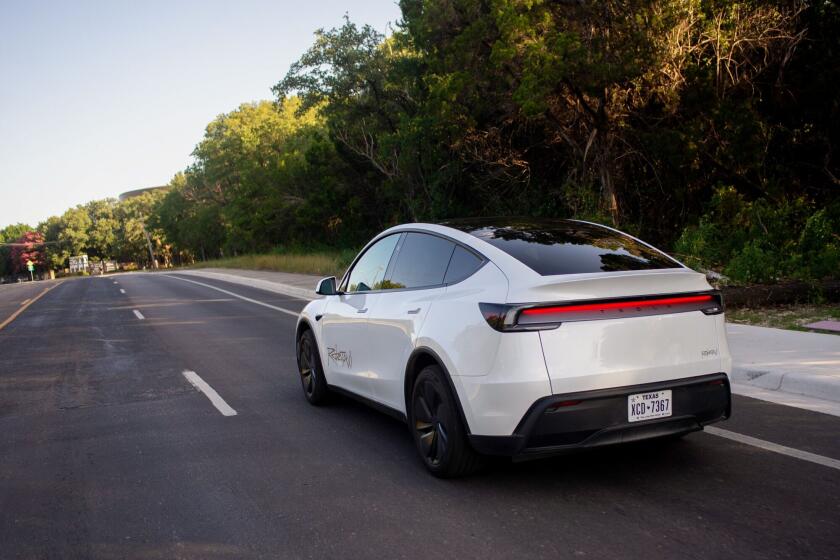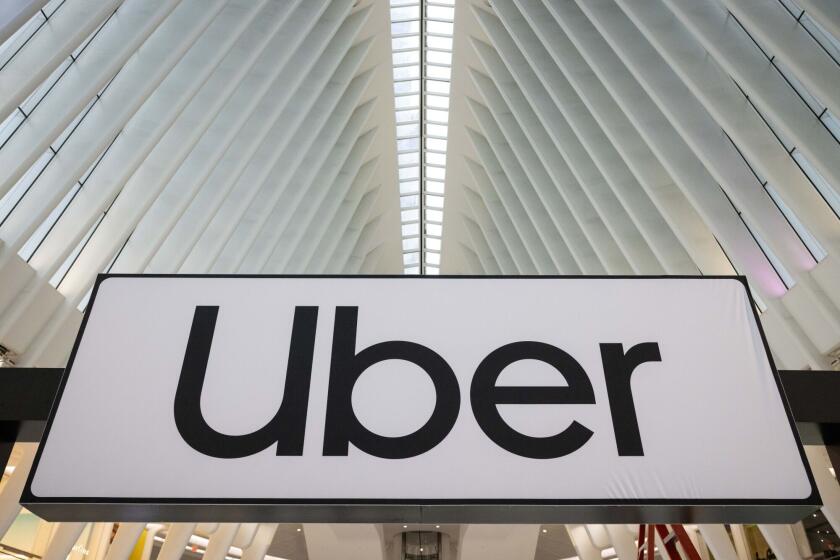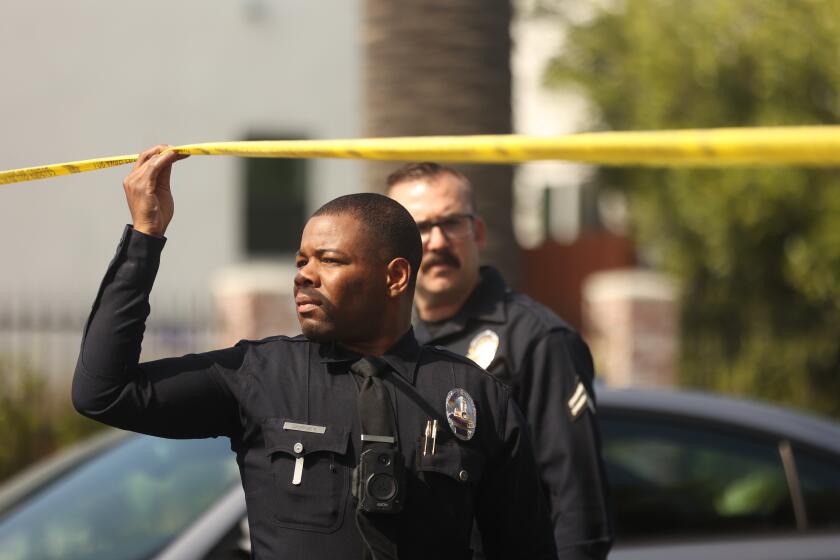Forum on transit problems inches toward solutions
- Share via
About a dozen elected leaders -- in a nice nod to irony -- gathered at the Petersen Automotive Museum last week to talk about mass transit in general and, more specifically, the proposed “subway to the sea.”
The gathering was organized by Los Angeles City Councilman Jack Weiss, who represents a healthy slice of the gridlocked Westside.
For about two hours, the public officials talked, talked and then talked some more. . . .
Was anything interesting or new said?
Yes and no. Everyone -- as we predicted last week -- agreed traffic was miserable. And pretty much everyone showed support for a subway, including representatives of Santa Monica, West Hollywood and Beverly Hills.
As for the cost of such a project, everyone also agreed it would take bundles of money that have yet to materialize.
In that spirit, L.A. Councilman Tom LaBonge said he favored a parcel tax on L.A. County residents and said he thought that most people would pay $52 per year (or as he put it, $1 a week) to fund transit projects across the county.
There is another funding proposal out there. Weiss last week asked the city to study whether a public-private partnership could be used. The idea would be to allow a private firm to build and run the subway, with government oversight.
“The amount of public capital for these projects is inherently limited by what people will vote for,” Weiss said. “Private capital markets are enormous, and maybe there’s a way to tap them” for the subway to the sea.
Such arrangements have been used on a variety of highway and mass transit projects around the world. One local example is the 91 Freeway express lanes linking Orange and Riverside counties.
A private firm built them and opened the lanes in 1996.
After seven contentious years, the lanes were sold to the state in 2003 for $207.5 million.
Hasn’t the office of Mayor Antonio Villaraigosa looked into the same thing?
Yes. It’s worth noting that Weiss and Villaraigosa are firm allies, and Weiss’ motion can be viewed as a possible trial balloon, perhaps being dispatched on behalf of the mayor’s office.
The obvious hurdle here is that the subway likely would cost at least $5 billion. Operating a subway is costly too, and it’s worth noting that many mass transit systems don’t turn a profit -- they need to be subsidized by the public.
So, it’s fair to wonder whether any private firms might view the subway as a good investment. And it’s fair to wonder about the fares a private firm might charge, compared with what the MTA charges.
Skepticism aside, it’s good to see that someone out there is thinking about how to pay for the train.
So, how bad is Westside traffic?
At 2:30 p.m. last Monday, it took 10 minutes to drive a half mile north on Fairfax Avenue to the transit meeting. In that vein, West Hollywood Mayor Pro Tem Jeffrey Prang was one of the more-interesting speakers at the meeting. While he supports the subway, Prang said, he believes it won’t meet the demand for transit on the Westside.
He believes more attention should be paid to roads, even if it means creating more room for buses and less for -- egad! -- private cars. On the Westside, those aren’t the kind of words you say in public unless you’re looking for a fight.
Has this column received any interesting mail lately?
Yes, piles of it. And we’ve been remiss in not sharing some of the more thoughtful entries from readers.
On the matter of last week’s item about the city employing “drought busters” to roam the city and look for wasteful uses of water:
One place the mayor should clean up for water waste is his own back yard -- city parks. I live next door to Elysian Park, and not a day goes by that I don’t see a broken irrigation pipe or head spewing hundreds of gallons of water, and these breaks go on for days if not weeks.
Matthew DuBois
Echo Park
Meanwhile, several readers commented on a recent item about chain stores taking over the city:
One thing you didn’t mention about the value of mom-and-pop operations is that the profits they make go back into the communities they serve.
Jeff Sirkin
El Paso, Texas
Within a mile of my house in North Orange County, there are now eight Starbucks, one Gloria Jean, one Coffee Bean and Tea Leaf franchises and three independent coffee stores.
I should point out that the independent coffee folks are not open when I go to work (6:30 a.m.), and their quality varies wildly when I do visit them at later times, especially when it comes to service.
The staff at the local places act as if disengaging from their inane debates about Dennis Kucinich to serve me is a major inconvenience. Yet, at Starbucks, I never fail to get a smile (even if I forgo the tip jar), and if I stick to just one of the eight from which I can choose, they greet me by name when I enter and know my preference.
Steven Ziemba
Fullerton
Los Angeles city and county last month held a “lights out” event to promote saving energy. We pointed out that turning off lights would also be good for viewing the night skies, bringing this response:
Illuminated billboards are one of the prime examples of America’s genius for wasted energy and public space uglification.
Lights Out will have value only if these events become the prelude to a massive reduction in commercial nighttime illumination that happens by law every night after a certain hour (say, at midnight).
It could be called the Cinderella Hour, and start with the curtailment of billboard illumination, and then of the many blazing-bright auto dealerships, then the many free-standing signs on closed businesses.
Gregory Wright
Sherman Oaks
In August, we ran a column that made the point that Los Angeles is not nearly as dense as Manhattan, as some critics of density in Los Angeles like to allege. As evidence, this column pointed to the many more skyscrapers in New York:
It is not so much about building height as it is about ground coverage. A truly sophisticated, urbane city -- such as many cities in Europe -- do not have to have tall buildings, but they have much less space devoted to cars and streets.
When we start doing simple things like expanding sidewalks instead of adding traffic lanes, then we will have turned an important corner psychologically. Fifty- and 60-story buildings sitting on top of parking decks surrounded by six- and seven-lane streets do not a European urbanity make.
Think about it. The liveliest parts of both cities -- such as Japantown, Santa Monica 3rd Street, SoHo, the Village, Tribeca, Chinatown -- are all in places where streets are very narrow, buildings cover nearly 100% of all non-street area.
Joe Russo
Costa Mesa
Several readers wrote about a recent item about the Wiener Factory losing its lease in Sherman Oaks. Some took issue with our statement that the all-time best hot dog can be found at Superdawg in Chicago:
The best ever remains Nathan’s in Coney Island. Even other Nathan’s locations don’t match up to it.
It all has to do with the equipment for grilling and the volume of sales. You can buy Nathan’s in the supermarket but can’t grill them the way they do at Coney Island. That’s part of the reason why Nathan’s didn’t make it in L.A. -- that and the fact that much of L.A. actually thinks Dodger Dogs are good.
Larry Levine
Los Angeles
Next week: While we’re speaking of the Dodgers . . .
More to Read
Sign up for Essential California
The most important California stories and recommendations in your inbox every morning.
You may occasionally receive promotional content from the Los Angeles Times.













